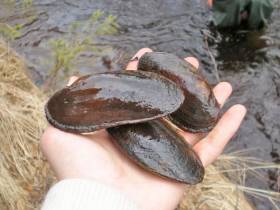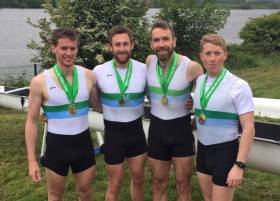Displaying items by tag: Curlew
Curlew Conservation Programme Having Positive Impact
Curlews along the Irish coastline are showing a positive trend, with the highest number of young fledged into the wild since 2017, according to a State conservation programme.
A total of 38 breeding pairs have been confirmed in the nine geographical areas of the programme – an increase of twelve pairs on last year.
Nationally, there are just 100 breeding pairs remaining in Ireland.
However, conservation efforts are having a “positive impact” on the curlew population, according to national breeding surveys.
The call of the large native wading bird, with long legs and a long down-curved bill, was once synonymous with the Irish landscape and has inspired song, poetry and stories.
The wader was once very widespread, even up to 30 years ago, but has since suffered a 98% crash in population, primarily due to changes in landscape and land-use.
A report issued during the final year of a dedicated conservation programme documents 42 chicks reaching fledgling stage in 2023, which is up from 19 in 2022.
The annual report of the Curlew Conservation Programme (CCP), a partnership between the National Parks and Wildlife Service (NPWS) and the Department of Agriculture, Food and the Marine, says this represents an increase of 221% in the number of chicks fledged.
“Our history, culture and communities have such a deep connection with this precious species and its unique call, heard for centuries on our meadows and wetlands,” Minister of State for Heritage Malcolm Noonan has said.
“The work pioneered by the Curlew Conservation Programme over the past seven years shows that there are practical conservation efforts that we can take to stave off extinction of the curlew.,” he said.
“ It also shows that we need to ramp these efforts up significantly, while also addressing wider land use changes. We will be announcing detailed plans to do just this in the very near future, building on the solid foundations that the Curlew Conservation Programme has provided,” he said.
He paid tribute to local communities, farmers and landowners for supporting efforts.
As ground nesting birds, curlews are vulnerable to predators, infield operations and disturbance. This is compounded by degradation and loss of habitat in landscapes.
The Curlew Conservation Programme was established in response to a national survey, which identified the scale of the loss and action required to save it from extinction.
In Ireland, the curlew population has declined by 98% since the late 1980s/early 1990s.
Over the past seven years, NPWS has worked together with the Department of Agriculture, Food and the Marine to support local teams on the ground on a wide range of conservation activities.
It was estimated in 2016 that the curlew had just ten years left until extinction in Ireland, but the efforts of the Curlew Conservation Programme appear to have, for now, helped stave off this extinction, Noonan’s department has said.
Curlew Conservation Programme areas include the Stacks Mountains (Kerry), Lough Corrib North (Galway). Lough-Ree (Roscommon Westmeath), North Roscommon/Mayo, Mid-Leitrim, North Monaghan, Donegal, Sliabh Aughties (Clare Galway), Laois/Kildare.
New Petition Claims Irish Curlew “Is Headed to Extinction”
Just 34 breeding pairs of curlew were confirmed in the fifth year of the Curlew Conservation Programme, according to figures in its 2021 report.
And of that number — recorded across nine important breeding areas — only nine pairs were confirmed to have produced fledglings, a breeding success rate of just 26%.
While the breeding productivity rate of 0.50 fledglings/breeding pair is above the threshold of 0.43 required for a stable population, it continues a significant trend of decline since 2019 when the rate was 0.81.
The figures have prompted an online petition to Minister of State Malcolm Noonan amid fears that the Irish breeding curlew “is headed to extinction” due to human activity.
It calls on the minister and the National Parks and Wildlife Service (NPWS) to take action on a number of points, including an immediate increase in funding for curlew conservation, and establishing an integrated stakeholder emergency taskforce” led by the current conservation programme.
It also appeals for allocating former Bord na Mona peatlands as priority habitats for curlews, and initiating a review of commercial forestry licensing “where the habitat is favourable to ground-nesting birds”.
“If these actions are not taken, the Irish curlew will be lost within the next decade,” the petition organisers say. “This will be a preventable tragedy we can not stand idly by and let happen.”
The wading birds are winter visitors to Ireland’s inland and coastal wetlands, but also breed in inland floodplains and bogland, in rough pastures, meadows and heather.
However, according to Birdwatch Ireland their numbers and range “have declined substantially in recent decades. It is likely that increased afforestation and agricultural improvement are responsible for these declines.”
Curlew in Ireland are red-listed as a threatened species.
Projects for pearl mussels and conservation of breeding curlew are among the 23 schemes being carried out nationwide under the European Innovation Partnership (EIP), as highlighted in a new exhibition in Dublin.
Agriculture House on Kildare Street is currently showcasing the innovation under the Department of Agriculture, Food and Marine’s EIP/locally led schemes in Ireland.
Speaking at the launch yesterday (Wednesday 17 April), Marine Minister Michael Creed said: “We are committed to building a sustainable agricultural system that respects the environment. The agriculture sector is determined to play its part in responding to the challenges before us on climate, water quality and biodiversity.
“We are investing €59m in these locally-led schemes to achieve these goals at a local level by stimulating and developing innovative new approaches to tackling environmental challenges in a targeted way. This targeted approach to specific challenges in specific areas can complement our larger national agri-environmental schemes.”
The exhibition highlights the varied works undertaken by the EIP Project groups including projects on biodiversity, organic production, pollinators, water quality, flood management, soils, farming in an archaeological landscape and targeting un-utilised agricultural biomass.
The exhibition is open to the public to visit before going nationwide to other DAFM offices for display there. Following its display in Dublin, the exhibition will be moving to the department’s office at Johnstown Castle Estate in Wexford.
Further details of the EIP and locally led schemes can be found on the DAFM website HERE.
Facile Win for Commercial in Second Round at Henley
#Rowing: Commercial won again at Henley Royal Regatta today. Their Wyfold club four beat Curlew with plenty to spare to progress to Friday’s competition. The London crew veered markedly towards Commercial at the start, and Commercial also crabbed to their right. Commercial then took control and were able to paddle home past the Enclosures and still win by four and a quarter lengths.
Henley Royal Regatta, Day Two (Irish interest)
Diamond Sculls (Open Single Sculls): J Stimpson bt N Kenny 3¼ l.
Temple Cup (College Eights): University of California, Berkeley bt Trinity 2½ l.
Wyfold (Club Fours): Commercial bt Curlew 4 ¼ l.































































